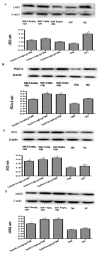Salvianolic acid A protects the peripheral nerve function in diabetic rats through regulation of the AMPK-PGC1α-Sirt3 axis
- PMID: 22996345
- PMCID: PMC6268602
- DOI: 10.3390/molecules170911216
Salvianolic acid A protects the peripheral nerve function in diabetic rats through regulation of the AMPK-PGC1α-Sirt3 axis
Abstract
Salvianolic acid A (SalA) is one of the main efficacious, water-soluble constituents of Salvia miltiorrhiza Bunge. This study investigated the protective effects of SalA on peripheral nerve in diabetic rats. Administration of SalA (0.3, 1 and 3 mg/kg, ig) was started from the 5th week after strepotozotocin (STZ60 mg/kg) intraperitoneal injection and continued for 8 weeks. Paw withdrawal mechanical threshold (PWMT) and motor nerve conduction velocity (MNCV) were used to assess peripheral nerve function. The western blot methods were employed to test the expression levels of serine-threonine liver kinase B1 (LKB1), AMP-activated protein kinase (AMPK), peroxisome proliferator-activated receptor-gamma coactivator-1alpha (PGC-1α), silent information regulator protein3 (sirtuin 3/Sirt3) and neuronal nitric oxide synthase (nNOS) in sciatic nerve. Results showed that SalA administration could increase PWMT and MNCV in diabetic rats; reduce the deterioration of sciatic nerve pathology; increase AMPK phosphorylation level, up-regulate PGC-1α, Sirt3 and nNOS expression, but had no influence on LKB1. These results suggest that SalA has protective effects against diabetic neuropathy. The beneficial effects of SalA on peripheral nerve function in diabetic rats might be attributed to improvements in glucose metabolism through regulation of the AMPK-PGC1α-Sirt3 axis.
Figures





Similar articles
-
Effects of salvianolic scid A on plantar microcirculation and peripheral nerve function in diabetic rats.Eur J Pharmacol. 2011 Aug 31;665(1-3):40-6. doi: 10.1016/j.ejphar.2011.03.054. Epub 2011 Apr 15. Eur J Pharmacol. 2011. PMID: 21510928
-
[Electroacupuncture improves peripheral neuropathy by up-regulating Sirt1/PGC-1α/TFAM pathway in type 2 diabetes rats with peripheral neuropathy].Zhen Ci Yan Jiu. 2024 Apr 25;49(4):349-357. doi: 10.13702/j.1000-0607.20221318. Zhen Ci Yan Jiu. 2024. PMID: 38649202 Chinese.
-
Salvianolic acid A protects against vascular endothelial dysfunction in high-fat diet fed and streptozotocin-induced diabetic rats.J Asian Nat Prod Res. 2011 Oct;13(10):884-94. doi: 10.1080/10286020.2011.598457. J Asian Nat Prod Res. 2011. PMID: 21972802
-
Dual control of mitochondrial biogenesis by sirtuin 1 and sirtuin 3.Mitochondrion. 2013 Nov;13(6):755-61. doi: 10.1016/j.mito.2013.04.002. Epub 2013 Apr 11. Mitochondrion. 2013. PMID: 23583953 Review.
-
Targeting post-stroke neuroinflammation with Salvianolic acid A: molecular mechanisms and preclinical evidence.Front Immunol. 2024 Jul 30;15:1433590. doi: 10.3389/fimmu.2024.1433590. eCollection 2024. Front Immunol. 2024. PMID: 39139557 Free PMC article. Review.
Cited by
-
Tongluo Zhitong Prescription Alleviates Allodynia, Hyperalgesia, and Dyskinesia in the Chronic Constriction Injury Model of Rats.Evid Based Complement Alternat Med. 2017;2017:8197281. doi: 10.1155/2017/8197281. Epub 2017 Dec 5. Evid Based Complement Alternat Med. 2017. PMID: 29358972 Free PMC article.
-
Activation of the AMPK-SIRT1 pathway contributes to protective effects of Salvianolic acid A against lipotoxicity in hepatocytes and NAFLD in mice.Front Pharmacol. 2020 Nov 30;11:560905. doi: 10.3389/fphar.2020.560905. eCollection 2020. Front Pharmacol. 2020. PMID: 33328983 Free PMC article.
-
Activation of AMP-Activated Protein Kinase-Sirtuin 1 Pathway Contributes to Salvianolic Acid A-Induced Browning of White Adipose Tissue in High-Fat Diet Fed Male Mice.Front Pharmacol. 2021 May 28;12:614406. doi: 10.3389/fphar.2021.614406. eCollection 2021. Front Pharmacol. 2021. PMID: 34122060 Free PMC article.
-
Crosstalk between Sirtuins and Nrf2: SIRT1 activators as emerging treatment for diabetic neuropathy.Metab Brain Dis. 2022 Oct;37(7):2181-2195. doi: 10.1007/s11011-022-00956-z. Epub 2022 May 26. Metab Brain Dis. 2022. PMID: 35616799 Review.
-
PGC-1α regulation of mitochondrial degeneration in experimental diabetic neuropathy.Neurobiol Dis. 2014 Apr;64:118-30. doi: 10.1016/j.nbd.2014.01.001. Epub 2014 Jan 11. Neurobiol Dis. 2014. PMID: 24423644 Free PMC article.
References
-
- Tesfaye S., Boulton A.J., Dyck P.J., Freeman R., Horowitz M., Kempler P., Lauria G., Malik R.A., Spallone V., Vinik A., et al. Diabetic neuropathies: Update on definitions, diagnostic criteria, estimation of severity, and treatments. Diabetes Care. 2010;33:2285–2293. doi: 10.2337/dc10-1303. - DOI - PMC - PubMed
Publication types
MeSH terms
Substances
LinkOut - more resources
Full Text Sources
Medical

